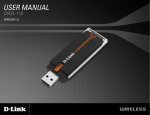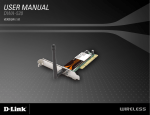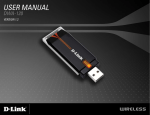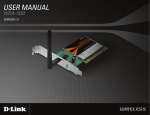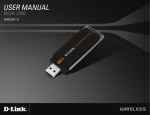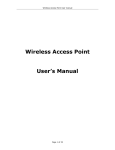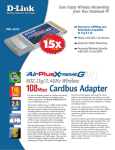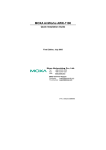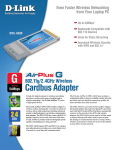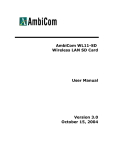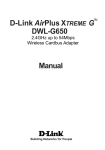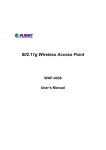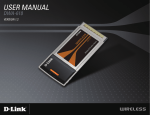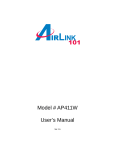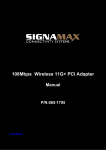Download User Manual - Airlink101
Transcript
Model # AWLC4030 User’s Manual Ver. 1A Table of Contents Package Contents ................................................................................................................ 3 System Requirements .......................................................................................................... 3 Introduction ........................................................................................................................... 4 Installation Considerations ................................................................................................... 6 Installing the Utility................................................................................................................ 7 Install Driver........................................................................................................................ 10 Using the WLAN Monitor .................................................................................................... 12 Troubleshooting .................................................................................................................. 22 Technical Specifications...................................................................................................... 23 2 Package Contents • 108Mbps SuperG Wireless Cardbus Adapter • Quick Installation Guide • Manual and Drivers/Utility on CD Note: If any of the above items are missing, please contact your reseller. System Requirements • A laptop computer with an available 32-bit Cardbus slot • Windows XP, Windows 2000, Windows ME, or Windows 98SE • At least 32 MB of memory and a 300 MHz processor or higher • An 802.11b/g Access Point for (Infrastructure Mode) or another computer with an 802.11b/g wireless card installed (for Ad-Hoc Mode) 3 Introduction The 108Mbps SuperG Wireless CARDBUS Adapter is an advanced IEEE 802.11b/g compatible, high performance wireless card that supports data transfer speeds of up to 54 Mbps or 108Mbps in SuperG mode. The 108Mbps SuperG Wireless CARDBUS Adapter comes with software drivers for the most popular Microsoft Windows operating systems and can be integrated into a larger network, running Windows XP, Windows 2000, Windows ME, Windows 98SE, in either Ad Hoc mode (without an Access Point) or Infrastructure mode (with an Access Point). Product Features • Compatible with IEEE 802.11b standard to provide wireless Ethernet data rates of up to11Mbps data rate • Compatible with IEEE 802.11g high rate standard to provide wireless 54Mbps data rate or 108Mbps data rate (108Mbps requires a SuperG enabled access point/wireless router) • Operation at dual 2.4 GHz frequency bands to meet worldwide regulations • Dynamic data rate scaling at 1, 2, 5.5, and 11Mbps for IEEE 802.11b • Dynamic data rate scaling at 6, 9, 12, 18, 24, 36, 48, 54,108 Mbps for IEEE 802.11g • Maximum reliability, throughput and connectivity with automatic data rate switching • Supports wireless data encryption with 64/128/152-bit WEP for security • Supports infrastructure networks via Access Point and ad-hoc network via peer-topeer communication • Built-in dual diversity antenna for reduction of interference in a multi-path environment • Supports AES enhanced security • Supports DFS/TPC for European operation • Supports CARDBUS (32-bit) Type II PC Card • User-friendly configuration and diagnostic utilities • Driver support for Windows 98SE, ME, 2000, and XP 4 LEDS The 108Mbps SuperG Wireless CARDBUS Adapter has two LEDs: POWER and ACTIVITY. Network Mode Network Activity LED Activity Both LEDs flash in unison Both LEDs flash alternately Both LEDs flicker dimly Searching for a Network Connection Associated with the Network, but No Activity Power Save Mode (Power-up or Reset) Card is disabled POWER LED – slow rate blink Only the POWER LED flashes 5 Installation Considerations Designed to traverse distances up to 900 feet (~300 meters), the 108Mbps SuperG Wireless CARDBUS Adapter lets you access your network from your computer virtually anywhere you want. Keep in mind, however, that the number and thickness of walls, ceilings or other objects that the wireless signals must pass through may limit the range. Typical ranges vary depending on the types of materials and background RF noise in your home or business. The key to maximizing the transmission range is to follow these basic principles: 1. Keep the number of walls and ceilings between the Access Point and your receiving device to a minimum - Each wall or ceiling can reduce your Wireless product’s range from 3-90 feet (1-30 meters.) For some businesses or for a large residential home deployment, it may be beneficial to have more than one access point with overlapping coverage. 2. Be aware of the direct line between Access Points and computers with wireless cards A wall that is 1.5 feet thick (.5 meters), at a 45-degree angle appears to be almost 3 feet (1 meter) thick. At a 2-degree angle it looks as if it were over 42 feet (14 meters) thick! Try to make sure that the Access Points and Cards are positioned so that the signal will travel in as straight a line through a wall or ceiling as possible for better reception. 3. Building Materials make a difference - A solid metal door or aluminum studs can have a negative effect on range. Try to position Access Points and computers with wireless cards so that the signal passes through drywall or open doorways and not other materials. 4. Make sure that the antenna is positioned for best reception by using the software signal strength tools included with your 108Mbps SuperG Wireless CARDBUS Adapter. 5. Keep your product away (at least 3-6 feet or 1-2 meters) from electrical devices or appliances that generate RF noise. For the average residence, range should not be a problem. If you experience low or no signal strength in areas of your home that you wish to access, consider positioning the Access Point in a location directly between the computers with wireless cards that will be connected. Additional Access Points can be connected to provide better coverage in rooms where the signal does not appear as strongly as desired. 6 Installing the Utility Step 1 Before installing the utility software, do not insert the cardbus adapter into your computer. If the cardbus is inserted already, Windows will detect the adapter and request for a driver. Click Cancel to quit the wizard and remove the cardbus adapter from your computer. Step 2 Insert the Driver & Utility CD into your CD drive. Step 3 Click on Install Utility at the autorun page. Note: If the autorun page doesn’t appear automatically go to Start, Run, and type D:\autorun.exe (where D is the letter of your cd drive) and click OK. Step 4 Click Next at the welcome screen. 7 Step 5 Click Next to accept the default destination folder to install the software or click Browse to manually select a different destination folder. Step 6 Click Next at the Select Program Folder screen. Step 7 Click Continue Anyway at the Windows Logo Screen. 8 Step 8 Verify “Yes, I want to restart my computer now” is selected and click Finish to restart your computer. 9 Install Driver Note: For Windows 98SE and ME users, you may be prompted to insert the Windows 98SE or ME CD during the driver installation. Be sure to have your Windows 98SE or ME CD ready. Step 1 After the computer is restarted, insert the cardbus adapter into the computer and wait for the Found New Hardware Wizard to appear. The Found New Hardware Wizard will look different depending on your operating system. Follow the on-screen instructions to complete the installation. Step 2 Select Install the software automatically and click Next. For Windows 98SE and ME, select “Search for the best driver for your device” and click Next. Verify all the check boxes are unchecked except for “Specify a location” and click Browse. Step 3 Select the driver from the “Driver” folder and click Next. 10 For Windows 98SE and ME, browse to D:\Driver folder (where D is the letter of your CD drive) and click OK then Next. Insert the Windows 98SE or ME CD if you are prompted to do so. Step 4 Click Continue Anyway at the Windows Logo Screen. Step 5 Click Finish. Restart the computer if you are prompted to do so. 11 Using the WLAN Monitor Note to Windows XP Users: You must disable the Wireless Zero Configuration Utility in order to use the WLAN Monitor. Please refer to the following steps to disable the Wireless Zero Configuration Utility. Step 1 Double-click on the Wireless Network Connection Icon in the system tray, then click on Properties or Advanced. Step 2 Go to the Wireless Networks tab, uncheck the “Use Windows to configure my wireless network settings” check box and click OK. 12 To open the CARDBUS Adapter’s utility, double-click on the WLAN Monitor Icon in the system tray. The utility automatically adds an available wireless network to the Preferred WLANs box. If no SSID is added, or if the SSID is wrong, please refer to the following steps to join the appropriate wireless network. Note: Be sure to remove the wrong SSID from the Preferred WLANs box before adding any new SSID. You can remove the wrong SSID by selecting it and clicking on Remove. Step 1 Select the SSID of the wireless network you wish to connect to from the Available WLANs box and click Add. Step 2 Verify all the settings are correct and click OK. 13 Step 3 Verify the SSID you have selected is in the Preferred WLANs box and click Apply. Step 4 A blue circle will surround the SSID you have chosen. Click OK. Step 5 Restart your computer to complete the wireless network connection. 14 Configuration Tab The Configuration tab displays a list of available Access Points. Available WLANs: displays a list of available Access Points that you can connect to. To update the list, click on Refresh. To manually add a SSID to the list, click on Add. Profile Group Control: once you have added all the SSID you want to the preferred WLANs, you can group them by giving them a name in the Profile Group Control box and click Add. Any settings you set to the group will automatically be applied to all WLANS belonging to that group. Preferred WLANs: you may add a preferred SSID which the wireless adapter will automatically connect to upon startup. To add a new SSID from the available WLANs list, select the desired SSID and click Add. To add a new SSID that is not listed in the available WLANs list, click on New and manually enter the name of the SSID. If you have more than one preferred WLAN, you may move the SSID up or down the list. Each time the computer starts up, the wireless adapter will attempt to connect to the SSID listed beginning from the top of the list. If you wish to configure the properties of a WLAN, highlight it and click on Properties. 15 Configuring WEP Encryption The following screen will appear after you click on the Properties button from the Preferred WLANs box. If your existing wireless network has WEP encryption enabled, you need to configure the wireless adapter with the identical encryption settings in order to establish a connection. Step 1 Verify that the Wireless network name matches the SSID of the Access Point you’re trying to connect to. Step 2 Verify the Authentication Mode is set to the same setting as the Access Point you’re trying to connect to. Step 3 Select WEP from the Data Encryption drop-down menu. Step 4 Choose the same Key length that the Access Point is using. Step 5 Enter the identical key in the corresponding key number Step 6 Make sure the default key is the same key number used by the Access Point. Note: both the key and the key number must be identical with the Access Point. Step 7 Click OK to save your settings. Step 8 Click Apply and OK. 16 Configuring WPA Encryption If your existing wireless network has WPA encryption enabled, you need to configure the wireless adapter with the identical encryption settings in order to establish a connection. Step 1 Go to the Properties screen of the preferred WLAN as described above and verify that the Wireless network name is the SSID of the Access Point you’re trying to connect to. Step 2 Choose WPA-PSK from the Authentication Mode. Select TKIP as the Data Encryption and click on the Authentication Config button. Step 3 Enter a passphare in the WPA Passphrase field and click OK. (Note: the passphrase must be between 8 – 63 characters long). 17 Status Tab Under the Status Tab you will find information on the connection state, hardware information, and advanced state. Connection Status: displays the status of the connection SSID: The SSID that the wireless adapter is connected to BSSID: The MAC Address of the Access Point that the wireless adapter is connected to Network Type: The network connection type Frequency: The frequency that the wireless adapter is using Channel: The channel number that the wireless adapter is using Data Encryption: Displays if WEP encryption is disabled or enabled Speed: Displays the speed of the connection Authentication State: Displays the authentication state Signal Strength: A bar shows the signal strength of the connection Hardware Information: Displays the MAC Address of the wireless adapter and the regulatory domain. Advanced State: Displays whether the radio signal is On or Off. 18 Option Tab Under the Option Tab, general settings and advanced settings are shown. General Setting: Auto launch when Windows starts up: check the box to launch the WLAN Monitor when Windows starts up Remember mini status position: remembers the mini status position Auto hide mini status: auto hides the mini status screen Set mini status always on top: the mini status screen will always stay on top of the desktop Enable IP setting and Proxy setting in profile: allows you to back up previous IP settings Group Roaming: Check the box to enable group roaming. WLAN type to connect: Infrastructure and Ad-Hoc network: for connecting to either an access point or a peer network client without the use of an access point Infrastructure: for connecting to an access point only Ad-Hoc: for connecting directly to another wireless client without using an Access Point or wireless router. (Both wireless clients must be set to using Ad-Hoc mode). Automatically connect to non-preferred networks: Check the box to connect to nonpreferred networks upon startup. 19 Advance Setting: Disable Radio: Check the box to disable the radio signal Radio Frequency: 802.11b/g switches automatically between 802.11b and 802.11g speed depending on the other wireless devices. 802.11b will only connect at 802.11b speed (11 Mbps or lower). Start ad hoc network: Choose the appropriate frequency for your ad-hoc network Ad-Hoc Channel: Choose the desired channel for your ad-hoc network. All devices in the ad-hoc network must use the same channel. Power save Mode: Fast Save - This setting consumes half the power. Max Save - This setting consumes the least power. Disable - This default setting consumes the most power. Transmit Power: Choose to transmit power from 100%, 50%, 25%, 12.5% and Lowest. Super G: Enable or Disable the Super G function (108Mbps). In order to transfer speeds at 108 Mbps, all wireless devices must be Super G compatible and set to use Super G. Fragmentation Threshold: Set the desired fragmentation threshold RTS Threshold: Set the desired RTS threshold 20 About Tab Displays the Driver and Utility version 21 Troubleshooting 1. How do I verify if the driver is installed correctly? To verify if the driver for the wireless adapter is installed correctly, follow the steps below. Step 1 Right-click on My Computer from your desktop and choose Properties. Step 2 Select the Device Manager tab. (For Windows 2000/XP, select the Hardware tab first then click on Device Manager). Step 3 Expand Network adapters and verify that IEEE 802.11g CARDBUS Wireless Network Adapter is in the list and that no yellow question mark or exclamation mark is beside it. Step 4 Close the Device Manager. If you do not see IEEE 802.11g CARDBUS Wireless Network Adapter in the list, try to reinstall the driver again. 2. The computer does not recognize the CARDBUS adapter. Make sure that the CARDBUS adapter is properly seated in the computer’s CARDBUS bus slot. If there are additional free CARDBUS slots, try to install the CARDBUS adapter in those slots. 3. The CARDBUS adapter does not work properly after the driver is installed. Restart the computer. In some cases, it will be necessary to restart the computer after installing the driver. If the device is not working properly and a yellow exclamation mark is displayed, then there is probably a resource conflict. In this case, make sure the computer system has a free IRQ and if necessary, uninstall the driver, restart the system, and repeat the driver installation procedure. 22 Technical Specifications Standards IEEE 802.11b IEEE 802.11g IEEE 802.11 Supported OS Windows XP Windows 2000 Windows ME Windows 98SE Frequency Range 2.4GHz ~ 2.462 GHz Data Rates 1, 2, 5.5, 11 Mbps (IEEE 802.11b) 6, 9, 12, 18, 24, 36, 48, 54 (IEEE 802.11g), 108 Mbps (must have Super G enabled access point/wireless router). Modulation Techniques IEEE 802.11g BPSK QPSK 16 QAM 64 QAM OFDM IEEE 802.11b DQPSK DBPSK DSSS CCK Data Security 64, 128, 154-bit WEP (Wired Equivalent Privacy) Encryption Diagnostic LED Power Network Temperature Operating: 0ºC to 55ºC (32ºF to 131ºF) Humidity 5% maximum, non-condensing 23 Internal Antenna Type Diversity Bus Type 32-bit Cardbus Security 802.1x WPA - Wi-Fi Protected Access (64-,128-WEP with TKIP, MIC, IV Expansion, Shared Key Authentication) Physical Dimensions L = 4.64 inches (114.3mm) W = 2.13 inches (54mm) H = 0.34 inches (8.7mm) Data Rates With Automatic Fallback 54Mbps; 48Mbps; 36Mbps; 24Mbps; 18Mbps; 12Mbps; 11Mbps; 9Mbps; 6Mbps; 5.5Mbps; 2Mbps; 1Mbps Range Indoors: Up to 328 feet (100 meters) Media Access Control CSMA/CA with ACK Power Consumption Transmit mode = 248mA Power Save mode = 28mA Standby mode = 4.66mA Modulation Technology Orthogonal Frequency Division Multiplexing (OFDM) Receiver Sensitivity 54Mbps OFDM, 10% PER,-68dBm 48Mbps OFDM, 10% PER,-68dBm 36Mbps OFDM, 10% PER,-75dBm 24Mbps OFDM, 10% PER,-79dBm 18Mbps OFDM, 10% PER,-82dBm 12Mbps OFDM, 10% PER,-84dBm 9Mbps OFDM, 10% PER,-87dBm 6Mbps OFDM, 10% PER,-88dBm 5.5Mbps CCK, 8% PER,-85dBm 9Mbps OFDM, 10% PER,-87dBm 2Mbps QPSK, 8% PER,-86dBm 1Mbps BPSK, 8% PER,-89dBm 24 Transmitter Output Power: 15dBm ± 2dB Technical Support E-mail: [email protected] Toll-Free: 1-888-746-3238 Web Site: www.airlink101.com 25


























